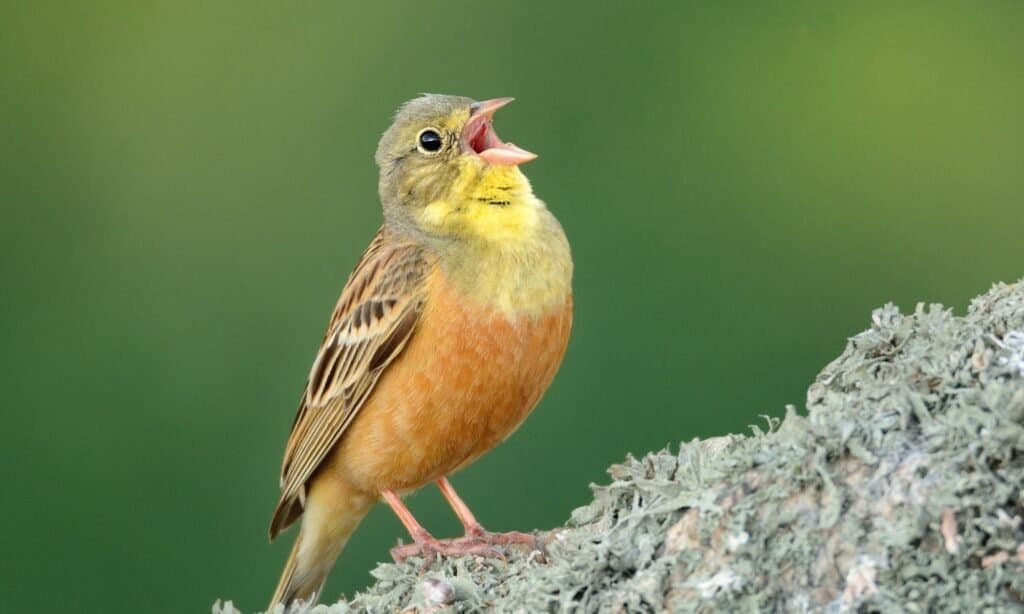Ortolan Bunting
Emberiza hortulana
The tradition of hiding your face with a napkin or towel while eating this bird was begun by a priest who was a friend of the great French gastronome Jean Anthelme Brillat-Savarin.
Advertisement
Ortolan Bunting Scientific Classification
- Kingdom
- Animalia
- Phylum
- Chordata
- Class
- Aves
- Order
- Passeriformes
- Family
- Emberizidae
- Genus
- Emberiza
- Scientific Name
- Emberiza hortulana
Read our Complete Guide to Classification of Animals.
Ortolan Bunting Conservation Status
Ortolan Bunting Facts
- Prey
- Insects
- Fun Fact
- The tradition of hiding your face with a napkin or towel while eating this bird was begun by a priest who was a friend of the great French gastronome Jean Anthelme Brillat-Savarin.
- Biggest Threat
- Being hunted for use as a French delicacy, habitat destruction, climate change
- Most Distinctive Feature
- Its use as haute cuisine
- Wingspan
- 10 inches
- Incubation Period
- 11 to 12 days
- Litter Size
- Four to five chicks
- Habitat
- Farms, towns, scrubland, deserts, woods and forests
- Predators
- Humans, birds of prey, cats, foxes, weasels
- Diet
- Omnivore
- Type
- Bird
- Common Name
- Ortolan Bunting
- Location
- Europe, western Asia, sub-Saharan Africa
- Nesting Location
- Near or on the ground
- Age of Molting
- 12 to 13 days
- Migratory
- 1
View all of the Ortolan Bunting images!
“The Ortolan Bunting is The Little Bird That is Forbidden Food”
Of all the weird gastronomic traditions humans indulge in, eating this inoffensive little bird is one of the weirdest and frankly, one of the cruelest. Yet it is a rite of passage for the well-heeled, as can be seen in TV shows such as Billions and Succession or just the curious, as can be seen in Anthony Bourdain’s travelogues. Read on for more information about the ortolan bunting:
Five Amazing Facts About the Ortolan Bunting
Following are five fascinating facts about the ortolan bunting:
- It has been eaten as a delicacy since the time of Ancient Rome.
- The way it’s prepared as a French delicacy is exceptionally gruesome. It is caught, force-fed, drowned in Armagnac, roasted then eaten whole, feet first.
- The traditional way to eat ortolan is with a napkin over your head. This is because eating the bird is so shameful that you need to hide your face from God. Others say it’s to capture the rich aroma of your food and to prevent fellow diners from seeing you spitting out the tiny bones.
- Eating the ortolan was banned in France in 1999, many years after the practice was banned in the rest of Europe. Still, the ban was mostly ignored.
- The cost of one ortolan prepared for the table can be as much as $200.
Where To Find the Ortolan Bunting
The bird is found in most of Europe, with populations found as far west as Mongolia and as far north as the Arctic Circle. It is found on farms, towns and scrub.
Ortolan Bunting Nests
The nest is constructed on or near the ground with stems, dried leaves, and grass, with a lining of hair, tiny roots, and more grass. It is not reused from one breeding season to another.
Ortolan Bunting Scientific Name
The scientific name of the ortolan, Emberiza hortulana is unusual because it is not based on Greek or Latin. The genus name Emberiza comes from the German word for “bunting” which is embritz. The species name comes from the Italian word hortulane, which means “ortolan bunting.” The bird is the only one in its genus and has no subspecies.
Ortolan Bunting Appearance
For all its popularity and controversy, the ortolan is a rather plain bird. It is small, with a length of 6.3 to 6.7 inches and a wingspan of about 10 inches. When it is prepared for eating, it is about as long as a man’s thumb. The males have a greenish-gray head along with a yellow throat, swooping mustache, and ring around the eye. Its belly is brown and its back and rump are brown and streaked. The females and juveniles are smaller, have spots on the belly, and are duller overall. Like most buntings, the ortolan has a conical beak that’s good for cracking seeds.

©iStock.com/phototrip
Ortolan Bunting Behavior
Ortolans are mostly solitary save the breeding season when they are seen in small groups looking for food. They are diurnal and spend the daylight hours searching for seeds or invertebrates. Invertebrates are a mainstay during the breeding season, and the birds appear to be partial to beetles. Males have a song that is a softer and sweeter version of the song of their cousin the yellowhammer.
Ortolan Bunting Migration Pattern and Timing
Ortolans are unusual for Emberizids because they’re one of the few species that migrate. They migrate to Africa in the fall, and this is when they are caught in nets and prepared to become the notorious French delicacy. The people who still catch the birds claim that their populations are large and stable, but it has been seen that those birds that fly through France come from populations in the northern and western part of the bird’s range. These populations are in decline.
The birds who are lucky enough to make it to Africa spend the winter in the woods and mountains of Guinea and Mali.
Ortolan Bunting Diet
Ortolans are omnivores. During the breeding season when they and their young benefit from animal protein they eat insects, but the rest of the time they eat seeds. During their migration, they can be seen gorging on seeds in cultivated fields. People who trap them throw them into cages or boxes, cover them up and fatten them up with millet.
Ortolan Bunting Predators and Threats
Besides humans, ortolans are preyed upon by birds of prey and carnivorous mammals including pet cats. Other threats are climate change, habitat destruction, and the overuse of insecticides that kill the insects that the bird eats.
Ortolan Bunting Reproduction, Babies, and Lifespan
The ortolan’s breeding season begins in mid-April and lasts till June, and they only reproduce once a year. Pairs are monogamous, and they usually keep a good distance from other pairs of mating birds. The female lays four to five eggs in a nest that’s often found on the ground and hidden with grasses or the shade of a bush, and she’ll sit on them for 11 to 12 days. She may be fed by her mate during the incubation period. The chicks are altricial, which means they are blind and helpless. Both parents feed and brood them. They leave the nest 10 to 13 days after they hatch and are ready to fledge a few days later. Their parents still take care of them for about another month. If it’s not eaten by humans or other beasts, the ortolan lives about six years.
Ortolan Bunting Population
The population of the Ortolan bunting in Europe is estimated to be about 8.9 million pairs. However, between 30,000 and 300,000 birds are captured to be turned into a French delicacy during their migration. Their conservation status remains least concern.
View all 66 animals that start with OOrtolan Bunting FAQs (Frequently Asked Questions)
Does the Ortolan Bunting Migrate?
The ortolan does migrate, but the cost of its migration is great numbers of them being caught and made into a decadent French delicacy.
How many eggs does the Ortolan Bunting lay?
The female lays four to five eggs. They are buff-colored with dark brown splotches.
How fast does the Ortolan Bunting fly?
It can probably fly between 20 and 45 miles per hour, which is how fast other buntings fly.
What is the Ortolan Bunting’s Wingspan?
The wingspan is about 10 inches.
When do Ortolan Buntings leave the nest?
Ortolan bunting chicks leave the nest when they’re between 12 and 13 days old.
Is eating ortolan illegal?
Eating ortolan is illegal but some people insist on doing it anyway. As each tiny bird can cost about $200, it is an indulgence of the rich.
Why do you eat ortolan under a napkin?
You eat the bird under a napkin because eating it is a sin, and you need to hide your face from God.
What does ortolan taste like?
People who eat the bird describe the taste as delicious. The fat is said to have a taste like hazelnut.
Are ortolan buntings endangered?
Ortolans are actually not endangered in most of their range despite the fact that tens of thousands of them are caught each year for an illegal feast.
Thank you for reading! Have some feedback for us? Contact the AZ Animals editorial team.
Sources
- CNBC / Accessed March 5, 2022
- Science / Accessed March 5, 2022
- Wikipedia / Accessed March 5, 2022
- Eater / Accessed March 5, 2022
- Atlas Obscura / Accessed March 5, 2022
- Smithsonian Magazine / Accessed March 5, 2022
- Britannica / Accessed March 5, 2022
- Forbes / Accessed March 5, 2022


















